The Tale of the Viracocha
Reading time: 7 min
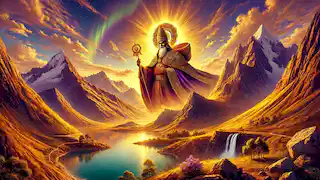
About this story: The Tale of the Viracocha is a Myth from Peru set in the Ancient This Dramatic tale explores themes of Wisdom and is suitable for All Ages. It offers Cultural insights. A journey through Peru's sacred myths, where creation and prophecy intertwine in a timeless legend.
In the mist-veiled peaks of the Andes, where the mountains scrape the sky and clouds drift lazily across jagged peaks, there lies a story that resonates with the heartbeats of Peru’s ancient stones. This is the tale of Viracocha, the revered god of creation and destruction, whose hand shaped the world as the Andean people know it. Carved in stone and whispered in wind, Viracocha’s story lives in the jagged crevices, the ancient temples, and the stories passed down through generations.
Long before men walked upon the Earth, the universe was an abyss—a void of silence and shadow, vast and unknowable. There was neither light nor land, just an endless sea and the echoes of emptiness. It was in this boundless darkness that Viracocha, the great creator god, stirred. Rising from the depths of Lake Titicaca, Viracocha looked upon the empty world and felt a surge of inspiration.
With a whisper that echoed like thunder across the waters, Viracocha began his work. He summoned mountains, valleys, and rivers, each forming under his gaze, while the first light bathed them in golden hues. He formed the land, shaping it with a gentle hand, drawing out the Andes from the earth's core to stand proud and eternal. With every breath, he created a new marvel, and with every step, the land transformed beneath his feet.
In his boundless wisdom, Viracocha was not satisfied with a barren landscape. From the soil, he fashioned the first beings, the progenitors of humankind, and placed them in the world he had created. They were his people, creatures woven from dust and life, and they revered him with a devotion that resonated in their songs and offerings.
Yet, Viracocha's creations did not live up to his hopes. These early beings were flawed, lost in their own desires and weaknesses. Their voices turned from praise to complaint, their lives marred by selfishness and cruelty. Heartbroken, Viracocha watched as his people turned against one another, and his once-beautiful world became tainted by their darkness.
As the god of creation and destruction, Viracocha knew what he had to do. He called forth a great flood, sweeping across the land to cleanse it of the disobedient and restore balance. Mountains crumbled, rivers swelled, and the earth itself seemed to shudder under the weight of his power. Only a handful of the virtuous survived, spared by Viracocha’s mercy and hidden in caves or high mountain passes. They would become the ancestors of a new humanity, molded in accordance with Viracocha’s vision.
When the waters finally receded, the land was a blank slate once more. Viracocha, filled with both sorrow and hope, crafted a new race of humans—one with the strength and resilience to respect and cherish the world he had given them. He spread these people across the mountains, valleys, and plains, blessing them with wisdom and courage.
Viracocha then traveled across his creation, teaching these new beings the arts of agriculture, weaving, and masonry. The places where he rested, where his feet touched the earth, became sacred sites. Villages sprang up around them, and over time, temples and cities were constructed in his honor. His presence lingered in the stones of these structures, forever entwined with the land itself.
In time, Viracocha grew weary of his earthly sojourn. His work was complete, and he knew it was time to return to the world beyond. Standing on a high mountain peak, he gazed upon the expanse of his creation, a smile of satisfaction on his face. With one final wave, he promised to return should his people ever need him again, then disappeared into the horizon, leaving only a whisper of his name in the winds.
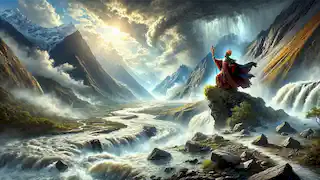
Centuries passed, and the people did not forget Viracocha. His legends were passed down, generation after generation, each retelling adding new layers of reverence and myth. The ruins of his temples were maintained with the utmost care, and his image was etched into stone, his memory immortalized in the mountains and valleys he had sculpted.
But not all was peaceful in the land Viracocha had left behind. New conflicts arose, and empires rose and fell. The Inca, mighty rulers of the Andes, claimed to be descendants of Viracocha, wielding his legend as a symbol of their divine right to rule. They believed that the strength of their empire came from their connection to the god of creation, that their bloodline was blessed by his divine power.
Yet, with this belief came a duty—a sense of responsibility to uphold the values of balance and respect for nature that Viracocha had instilled. The Inca people built vast temples in his honor, creating intricate stone structures that seemed to defy gravity itself. The Temple of the Sun in Cusco, the grand fortress of Sacsayhuamán, and the hidden city of Machu Picchu were each dedicated, in part, to the god who had given them life and wisdom.
It was during this time that Viracocha’s prophecy began to take shape. The priests and shamans spoke of a vision—a time when Viracocha would return, coming from the distant seas, to bring change to the world he had created. They looked to the horizon, watching the waters with both hope and fear, wondering if they would be deemed worthy in the eyes of their creator.
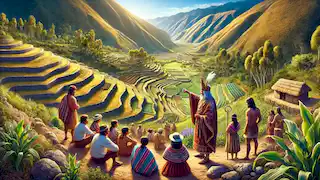
The prophecy lingered in the minds of the people, shaping their actions and their dreams. And then, one day, a stranger arrived on the shores of Peru. His skin was pale, his clothes strange, and his manner foreign. Word spread quickly: some believed this man was Viracocha himself, returned to fulfill his ancient promise. The stranger brought with him weapons, animals, and a thirst for gold—a hunger that did not match the tales of Viracocha’s benevolent wisdom.
Yet, the Inca were in awe. Their hesitation and reverence for the prophecy caused them to falter, granting the stranger’s party time to establish a foothold in their lands. The initial awe soon turned to betrayal, and betrayal to conflict. The stranger, whose name was Pizarro, led his soldiers against the Inca, shattering their empire and bringing ruin to the land that Viracocha had created.
In the devastation, the people cried out to Viracocha, praying for his return, for his mercy, and for his protection. But the god did not come. The temples fell, the lands were taken, and the knowledge of the ancient ways was nearly lost.
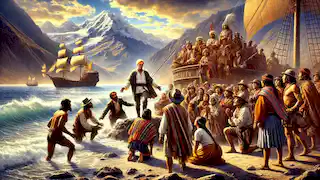
The surviving descendants of the Incas continued to honor Viracocha in secret, preserving his memory through quiet rituals and hidden symbols. Despite the foreign influence that swept across their lands, they clung to their faith, believing that one day, Viracocha would return to right the wrongs and restore harmony to the world.
As the years turned into centuries, Viracocha’s name became a whisper in the Andean breeze, a silent prayer echoed by the mountains themselves. He was not forgotten, nor was his legacy diminished. Even as modern life took hold, the stones of ancient temples remained, hidden away from time and memory, guarding the tales of the great god who shaped the Earth.
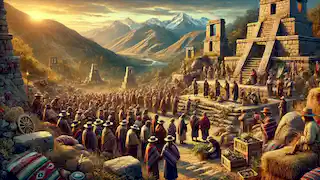
Today, in the villages that dot the Andean landscape, the story of Viracocha is told by the fire, his legend passed from elder to child. In the eyes of the people, he lives still, a presence felt in the towering mountains and the roaring rivers, in the first light of dawn and the silent beauty of dusk. Though he may be unseen, his spirit endures, and his promise remains. For in the hearts of the Peruvian people, there is a deep belief that one day, Viracocha will return, as he once promised, bringing with him a new dawn of balance, peace, and renewal for all.


















